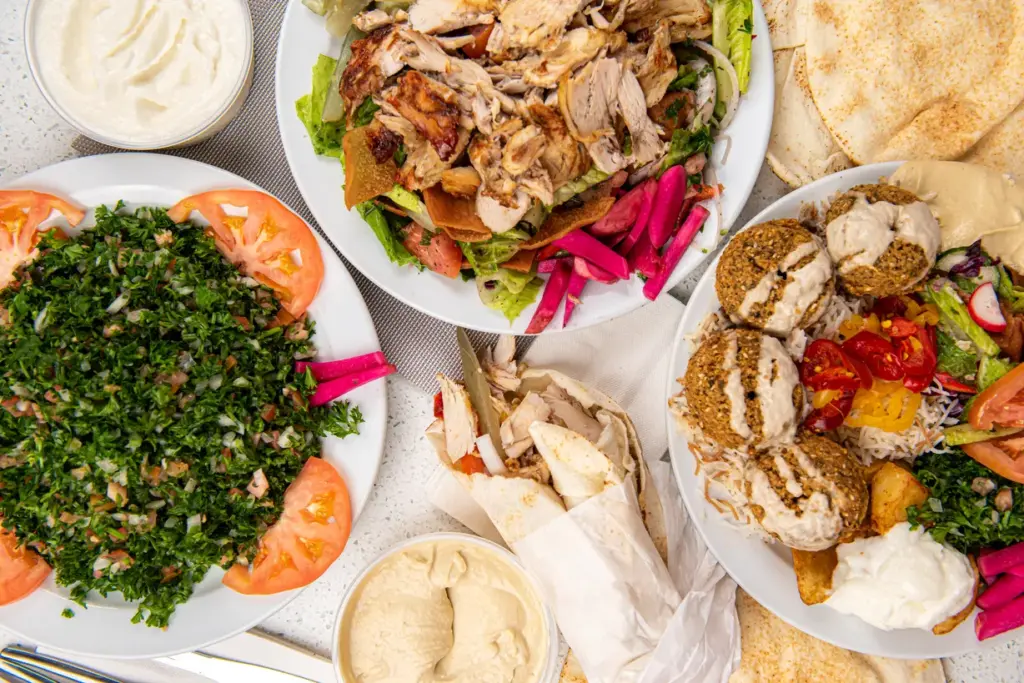Lebanese Delicacies: The Flavors of Mezze and Shawarma
Introduction
Lebanon, a country known for its rich cultural heritage, has an equally rich culinary tradition that captivates food enthusiasts around the globe. Among the many dishes it offers, Lebanese Mezze and Shawarma stand out, offering a treat to the taste buds.
This article delves into the delightful world of Mezze and Shawarma, exploring their origins, flavors, and the best places to savor them. Whether you’re planning to visit Lebanon or looking to try Lebanese cuisine near you, this guide will offer valuable insights.
Origins of Mezze and Shawarma
Mezze, which means ‘taste’ or ‘snack’ in Arabic, is a collection of small dishes served as appetizers before the main meal. This tradition traces back hundreds of years and is believed to have roots in the Ottoman Empire. The term ‘shawarma,’ on the other hand, comes from the Turkish word ‘çevirme,’ which means ‘turning,’ indicating the method used to cook meat on a vertical rotisserie.
While both dishes have evolved over time, they have retained their essence, offering a blend of flavors that reflect Lebanese culture and heritage. Mezze and Shawarma are integral to Lebanese dining and social gatherings, highlighting the importance of sharing meals in Lebanese society.
Exploring the Flavors of Mezze
Mezze comprises an array of dishes, each with its unique flavor and texture. From creamy dips to crunchy salads, the variety ensures there’s something for everyone. Some popular Mezze dishes include Hummus, Baba Ghanoush, Tabbouleh, Falafel, and Kibbeh.
Hummus, made from blended chickpeas, tahini, lemon juice, and garlic, is a staple in Mezze. Its creamy texture and tangy flavor make it a favorite. Baba Ghanoush, another popular dip, is made from roasted eggplants, tahini, garlic, and lemon juice, offering a smoky taste.
The Art of Making Shawarma
Shawarma, a popular street food, is made by stacking marinated meat (usually lamb, chicken, or beef) on a vertical rotisserie. As the meat turns slowly, it cooks evenly, and the outer layers are shaved off to serve. The marination process involves a blend of spices, garlic, and yogurt, contributing to its unique flavor.
Shawarma is typically served in a pita or flatbread, accompanied by various toppings like pickles, tomatoes, onions, and tahini sauce. The combination of juicy meat and fresh vegetables makes it a satisfying meal for any time of the day.
Best Places to Enjoy Mezze and Shawarma in Lebanon
To experience authentic Mezze and Shawarma, visiting Lebanon is a must. Beirut, the capital city, offers countless restaurants and street food stalls where you can indulge in these delicacies. Some renowned places include Al Falamanki, Em Sherif, and Barbar.
Outside Beirut, cities like Tripoli and Byblos also boast excellent options for Mezze and Shawarma. Whether dining at a high-end restaurant or a local eatery, the quality and flavors of these dishes remain unparalleled.
Recreating Lebanese Mezze and Shawarma at Home
If a trip to Lebanon isn’t in your immediate plans, you can still enjoy these delicacies by making them at home. Numerous recipes are available online, guiding you through the process of preparing Hummus, Baba Ghanoush, and Shawarma.
The key to achieving authentic flavors lies in using fresh ingredients and traditional spices. With a little effort, you can recreate a Lebanese culinary experience in your own kitchen, impressing family and friends with your cooking skills.
Conclusion
Lebanese Mezze and Shawarma offer a delightful culinary journey that reflects the rich cultural heritage of Lebanon. Whether you’re enjoying them in a Lebanese restaurant or making them at home, these dishes promise an explosion of flavors that will leave you craving for more.
So, why wait? Plan your trip to Lebanon or visit a local Lebanese eatery to savor these mouthwatering delicacies. Embrace the flavors of Mezze and Shawarma, and let your taste buds embark on an unforgettable gastronomic adventure.



